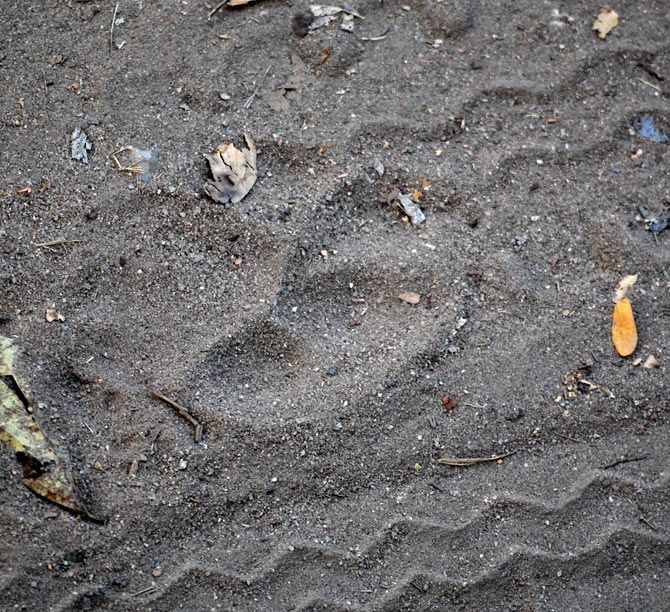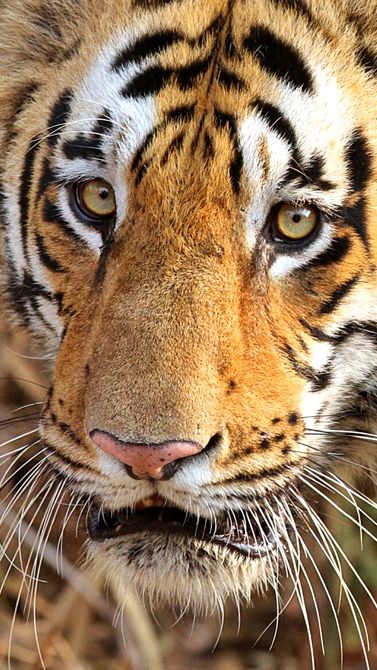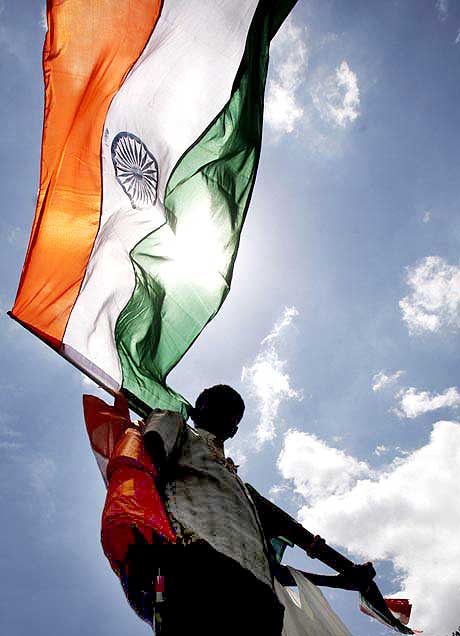'We turn around and see a Bengali family, a set of six, nervous, anxious and monkey-capped; one of them looking around in the bushes through his telescopic lens. Some of them were in the act of stuffing their faces with potato wafers acquired at the gates and now they sit frozen and goggle-eyed, the momentarily-forgotten food silently falling on their woollens.'
'Why can't the tigers just sit around and do whatever it is that the tigers do? Then comes the answer: The tiger is always on the move.'
Shubir Rishi/Rediff.com continues his jungle adventure and narrates the morning safari on day 2 at the Pench National Park.

Day 2
Right after dinner the day before, we are given rather stern instructions (by a solemn-faced Mrs Thakur), to be kitted and be present at the hotel lobby at 6:30 am sharp, not a minute late, and that the Maruti Gypsies would come and take us to the park for the morning safari.
But a word about the night before. Most resorts near the national park are practically within the boundaries of the jungle, and hence, the areas around are not much populated. As a result, there is hardly any ambient light or pollution, unlike towns or city. So as a happy by-product, the night is clear and silent, and one can actually see the sky full of millions and millions of stars.
And the awesome phenomenon when you can see both the sun and the moon in the wee hours. I don’t know how many hours we spend in the balcony, fixing our tripods and trying to capture it, in vain.
Meanwhile, an enterprising person from the team has coaxed one of the locals to part with a bottle of the local liquor -- Mahua -- derived from a tree of the same name, and we are pretty excited to have a taste.
But one whiff at the bottle’s potent content convinces us to leave it alone and call it a dry night.

So here we are at 6:30 am, wrapped in woollens (the temperature has dipped, and considering that most of us arrived from Nagpur the day before which was like a furnace) en route to the park in an open Gypsy, and chattering excitedly, for this is the best time to see the fauna, especially the tigers. We request to be the first vehicle from our group to enter the park, which is surprisingly, agreed upon and arranged by Siddharth, the go-to man.
But as soon as we reach the gates, we are dismayed to find that about 20 cars have already beaten us to pole position.
So we do what all beaten men must do; get off our cars and line up at the shop that is selling cups of sickeningly sweet milky concoction that passes off as tea (we gulp down as many as we can anyway, it is devastatingly delicious), and wait for our entry passes to be prepared.

The entry to the park is dotted with shops selling tea and snacks and stuff usually associated with jungle safaris -- memorabilia, caps, hats of all kinds, scarves for your head, scarves for your lens!
I briefly talk to a German couple with unpronounceable names. They inform me that they have been camping at the reserve for the last six days and have yet to see a tiger. This does not exactly lift one's spirits.
The forest officials at Pench need only one identity proof from a party of six, and then all your names are methodically and painstakingly entered (by hand) in a register, with five elbows digging in your ears at all times; for the counter is small and the people are many. So it gets a tad chaotic.
The deal is that you cannot change your cars after that and you are ‘stuck’ with your companions. How these officials actually manage to remember faces to a car is, quite honestly, a mystery.
But all that is forgotten once we are through the gates and a few scared deer leap out of the very slow moving vehicle 200 metres ahead, and our hopes to catch a tiger are back with much vigour.

Ten minutes go by and we spot the first pug marks of the day. The guide leaps up and balances himself on the front seat, the driver automatically slows down as if riding the same telepathic wavelength, and everything goes deathly silent. The tigress actually sat at this spot with her cubs and played with them for a bit. A car behind us noisily comes to a halt.
We turn around and see a Bengali family, a set of six, nervous, anxious and monkey-capped; one of them looking around in the bushes through his telescopic lens. Some of them were in the act of stuffing their faces with potato wafers acquired at the gates and now they sit frozen and goggle-eyed, the momentarily-forgotten food silently falling on their woollens.
Five minutes pass and there is no sound except the soothing snores of the person seated in the extreme corner, who claims on being sharply woken up that the silence was a bit much for him.
“Cholo cholo,” says someone in the car behind, and the engine loudly comes to life (making each one of us wince) and speedily goes past us. In reflection, when you drive in the jungle, you follow an unwritten code (or maybe it is written somewhere) -- no honking, no speeding, no sudden engine starts, and definitely no screeching of tyres. I wonder what these jungle drivers would say if they ever had to drive around in a large city.
Later, back at the camp, we all agree upon how awesome it would have been if we had been allowed to drive around in the Mahindra XUVs (provided they came equipped with large sunroofs!). But we are furtively thinking: why can't the tigers just sit there and do what tigers do? Pat comes the answer: The tiger is always on the move.

Then Sujith, our sharp-eyed colleague, elbows me and taps the driver’s shoulder. There it is, in all its ridiculously bright colours -- a wild rooster (or a red jungle fowl, if you prefer). Apparently a hen is around, and the rooster is playing the seductor, preening itself, chest puffed, head held high and checking out this and that.
As if out of habit, our guide clears his throat and whispers, “This is a rare sighting, they are quite difficult to spot in the jungle like this.”

When none of us comment (partly because by now we have caught on to the liberal use of the word ‘rare’; a fact confirmed by others from our rather large group), he doesn’t miss a beat and points out to a bunch of gregarious Jungle Babblers (seven sisters) who are continually chattering and making harsh mewing calls.
When this too fails to get our attention, he grumpily nudges the driver to move on, chop chop and everything. We also spot a solitary Kingfisher, looking lost in thought.
We come across a meadow and some massively-built bovines, which the guide confirms are the ‘Indian Bison’ or Gaur. They are quite a sight -- standing over six feet tall, the Gaur’s horns are magnificently curved upwards, and a typical male can weigh more than a tonne (1,000-1,200 kg)!
An immediate argument ensues -- who is bigger? The Gaur or the American Bison? The majority in my group favours the Bison, but the guide, at once jumps to the Gaur’s defence and confirms that it is indeed larger and stronger than its American brother. In fact, the Bison is outweighed by almost 400 kilos!

We are also told that the Gaur is the fourth largest land animal in the world (the others being the African elephant, the rhinoceros, and the hippopotamus). It also holds the distinction of being the largest bovine in the world.
We leave these gentle giants as other cars line up behind us, signalling to us that they too have not sighted any tigers yet. By now, all of us have worked out a system – if a car passes by us, all we have to do is raise our eyebrows -- if it is a vigorous shake of the head, its a nay. So far, we haven’t come across any triumphant looks.
Nearly four hours have passed and it is time for us to turn back now, and with complete (and a tad disappointed) silence, we cover that distance, with hopes that we might just see a tiger still.
But curiously, we meet the same bunch of animals that we had met during the last safari. At least in my opinion. Two occasions stand out, and I think I am pretty certain about that.

The first was a baby monkey which refused to budge from the road and it took a lot of shooing and catcalls to get it moving a little. It looked completely lost in thought.

Another one was an owlet who had been sitting in the same spot on a wire, since the previous day, its eyes, unblinking and scowling, and unimpressed.

And as if by sheer tradition, because it must say that in the International Almanac for Forest Keepers, our guide leaves us with this knowledge, “You will not see a tiger unless he wants to be seen. Take heart.”
And hence, ends our time at Pench. The next stop: Kanha National Park.
Day 1: Oh, to catch a tiger, by its tale!
Day 3: Along came a tigress...










